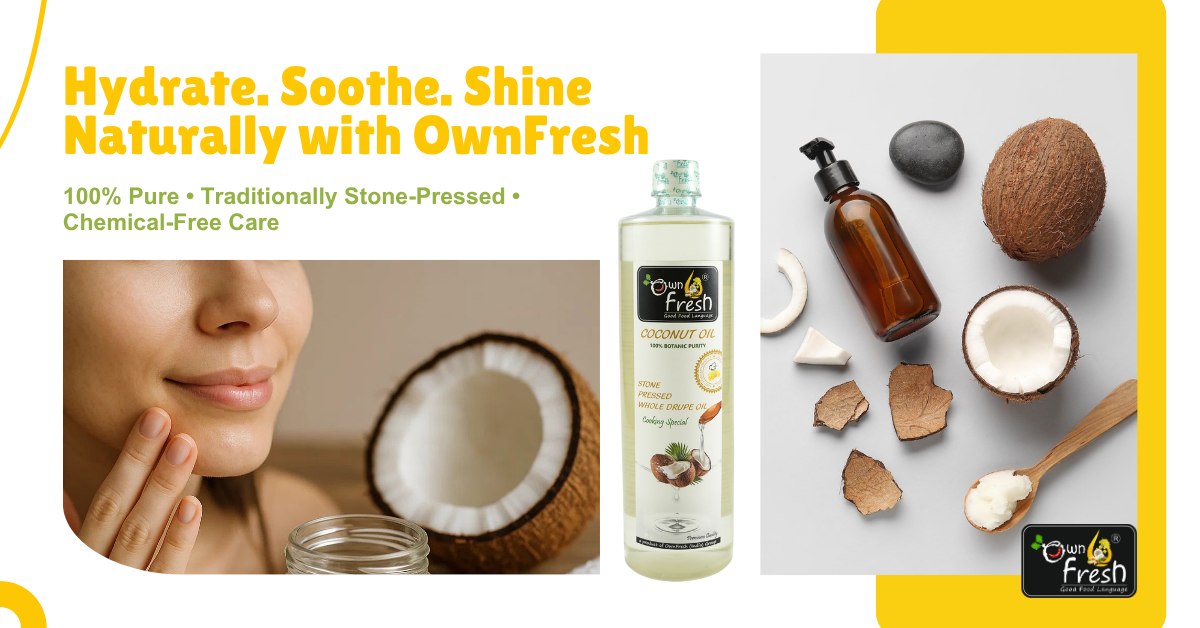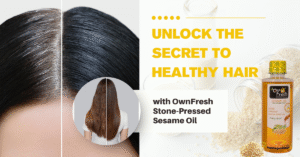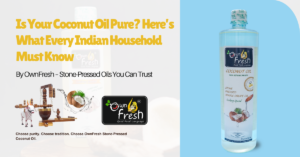At OwnFresh, we believe your skin deserves care that’s simple, effective and gentle. Among many natural oils, stone-pressed coconut oil stands out for its long history in Indian households and its potential to nourish skin deeply. In this article, let’s explore how you can use stone-pressed coconut oil on face safely, its benefits, caveats, and tips all in a straightforward, trustworthy way.
What is stone-pressed coconut oil?
Stone-pressed coconut oil is extracted by grinding coconut meat between stones in a traditional way. This method generates less heat, allowing more of the beneficial nutrients (like fatty acids and natural antioxidants) to remain intact. The result is a pure, mildly scented oil that can support skin health without harsh processing.
Why consider coconut oil for your face?
Coconut oil is not a miracle cure-all, but used wisely, it offers multiple benefits for many skin types. Here are the key advantages:

- Deep moisture lock
Coconut oil is good at sealing in moisture, so dry patches get smoother and your skin feels softer throughout the day. - Calms irritation
Its natural soothing properties help reduce redness, especially after harsh weather or sun exposure. - Antioxidant support
Coconut oil contains compounds that fight free radicals, helping slow down early signs of aging. - Gentle make-up remover
It can dissolve light makeup (like lipstick or powder) without the need for strong chemicals especially useful for people avoiding harsh products. - Strengthens skin barrier
Regular, light use may help reinforce the skin’s outer layer, making it more resilient to external stressors like pollution or dust.
However, one must be careful coconut oil is comedogenic (can clog pores) for some people, so it may not suit everyone, especially those with acne-prone or very oily skin.
How to use stone – pressed coconut oil on your face
Here is a step-by-step method we at OwnFresh recommend, to get benefits without unwanted side effects:

- Patch test first
Always test behind your ear or on the jawline for 24 hours to check for any reaction. - Clean face gently
Use a mild face wash to remove dirt, sweat, and makeup. - Pat dry
Don’t rub gently pat dry with a soft towel. - Warm a small amount
Scoop a tiny pea-sized bit of oil. Warm between your fingertips it will melt on contact. - Apply lightly
Massage using upward circular strokes. Focus on drier areas like cheeks and under eyes; avoid heavy application on T-zone if you tend to have oily skin. - Decide time
- As night moisturiser / Mask: Leave it overnight (if your skin handles it well)
- Short mask / rinse off: Keep for 10–15 minutes, then wash off
- Day use (Limited): If used during the day, apply a thin layer and always follow with sunscreen.
- As night moisturiser / Mask: Leave it overnight (if your skin handles it well)
- Clean hands or Spatula
To avoid contamination, don’t dip fingers straight into the jar. Use a clean spoon or spatula.
Safety tips & precautions
- Use sparingly : a little goes a long way. Overuse may leave a greasy film.
- Night time preferred for heavier oils : daytime use can feel too heavy or interact poorly with SPF or makeup.
- Check reactions : if you see sudden breakouts or clogged pores, stop usage and reassess.
- Store well : keep your jar in a cool, dry place, away from direct sun, to preserve its quality.
Who might benefit most and who should be careful?
Best suited for:
- Dry, flaky or winter stressed skin
- Normal to combination skin types that tolerate richer oils
- Skin needing extra soothing after sun or environmental exposure
Be cautious if you have:
- Acne-prone or very oily skin
- A history of clogged pores or frequent breakouts
- Sensitive skin that reacts easily to richer oils
In such cases, try using coconut oil just on dry patches or mix it with lighter oils to dilute.
We at OwnFresh encourage you to explore stone-pressed coconut oil as a gentle, time tested option in your facecare routine. It is not a guaranteed solution for everyone, but it does offer natural hydration, barrier support, and soothes your skin in many weather conditions across India. The key is to listen to your skin use small amounts, test carefully, and adjust based on what works.




